2006 VOLKSWAGEN GOLF MK5 airbag off
[x] Cancel search: airbag offPage 151 of 444
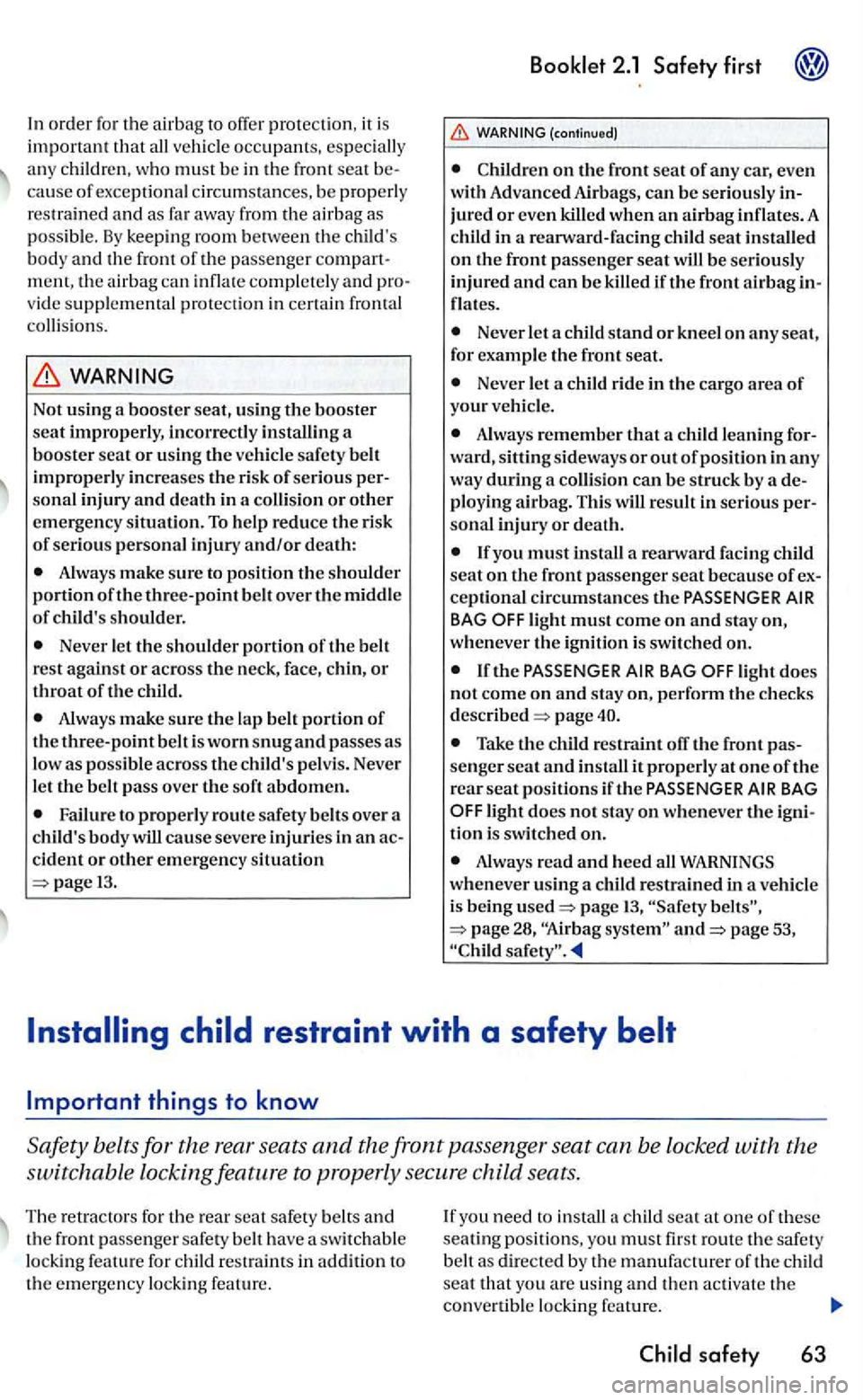
In order fo r th e air bag to otTer prote ction , it is
important that ve hicle occupants, es peciall y
a ny children , who must be in the front seat cau se of e xc e ptional circum stances , be prop erl y
r es trained and as far away from the airb ag as
possible. B y keep ing room be tween th e ch ild 's body and the front of the passe nger ment, the airbag can inflate complet ely and vid e supplemental protection in ce rtain frontal
c olli sions.
Not usi ng a booster seat, usin g the booster seat improperl y, incorrectly installing a booster seat or using the veh icle safe ty belt
improperly increases the risk of serious sonal injury and death in a or other em erg ency situation. To help reduce the risk of serio us personal injury and/or death:
Always make sure to position the shoulder portion of the three-point belt over the middle of child 's shoulder.
Neve r let the shoulder portion of the belt
res t against or across the neck, face, chin, or throat of the child.
Always make sure the lap belt portion of the three-point belt is worn snug and passes as low as possible across the child' s pelvis. Never
let the belt pass over the sof t abdomen.
Failure to properly route safety belts over a child's body will cause severe injuries in an
13.
(continued)
Childre n on the front seat of any car, eve n
with Advanced Airbags, can be seriously jured or even killed when an airbag inflates. A
child in a rearward-facing child seat in stalled on the front passenger seat will be seriously
injured and can b e killed if the front airbag flate s.
Never le t a child stand or kneel on any seat, for example the front seat.
Never let a child ride in the cargo area of your ve hicl e.
Always remember that a child leaning
ploying airbag. This will result in serio us sonal injury or death.
lig ht does not come on and stay on, perform the checks page
Take the child restraint off the front senger seat and AIR BAG light does not stay on whenever the tion is swi tc h ed on.
A lwa ys read and heed all WARNINGS w henever usin g a child restrained in a vehicl e
is being page 13, page 53,
safety 63
Page 176 of 444
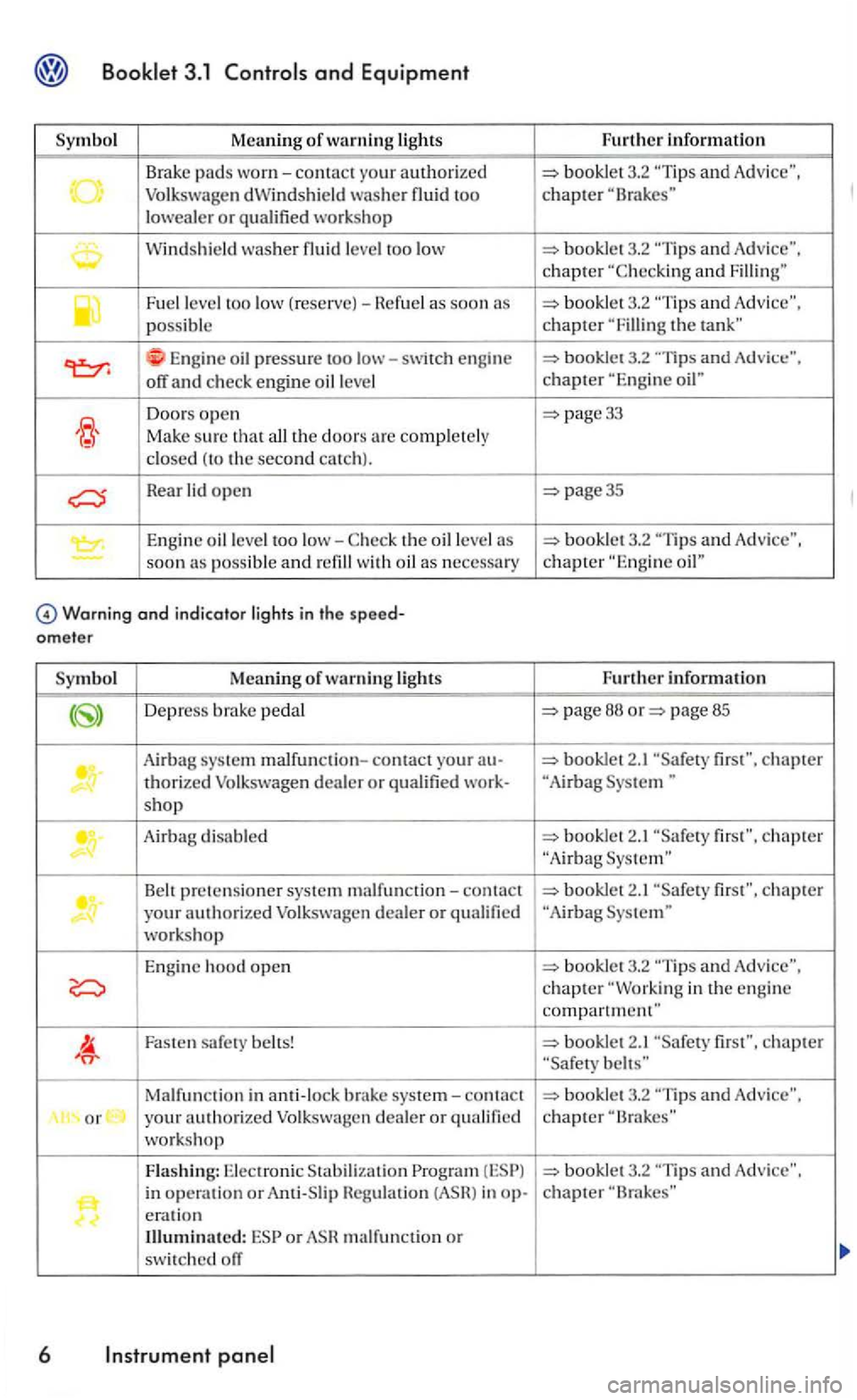
3.1
M eaning o f warning lights
Brake
pads worn-contact your authori zed Volkswagen dWindshield was her fluid too lowealer or qualified workshop
Windshield washer fluid level too low
Fuel level too low (reserve)-Hefuel as soon as possibl e
Engin e oil press ure too low-engine
off and ch eck en gine oil leve l
Do ors open
Make su re tha t all the doors completely cl osed (to the second catc h ).
lid open
Engine oil level too low-
Warning and indicator light s in the
Meaning of warning lig h ts
Dep ress ped a l
Airbag system malfunction-contact your au -
thorized Volkswagen dealer or qualified work-shop
Airbag disabled
Belt prete n sioner system malfu nction-contact your authorized Volkswagen dealer or qualified workshop
En gine hood open
Fasten safet y belts!
Malf unction in anti-loc k brake syste m -contact
o r your auth orized Volk swagen dealer or qualifi ed
work shop
Flashing: Electroni c Stab iliza tion in operation or Hegulat io n in op-eration Illuminated: or m alfunct ion or
sw itched off
6
and
3 .2 chapter and
3.2 and chapter the
booklet 3.2 chapter
page33
page35
3.2 and Advice" , chapter
page 88 page 85
2.1 fir st" , c hapte r
chapter "Airbag
booklet2.1
booklet 3.2 and Adv ice",
chapter
2. 1 first", chapter
bookl et3.2 and
bookle t3 .2 and A dvice" . chapter
Page 225 of 444
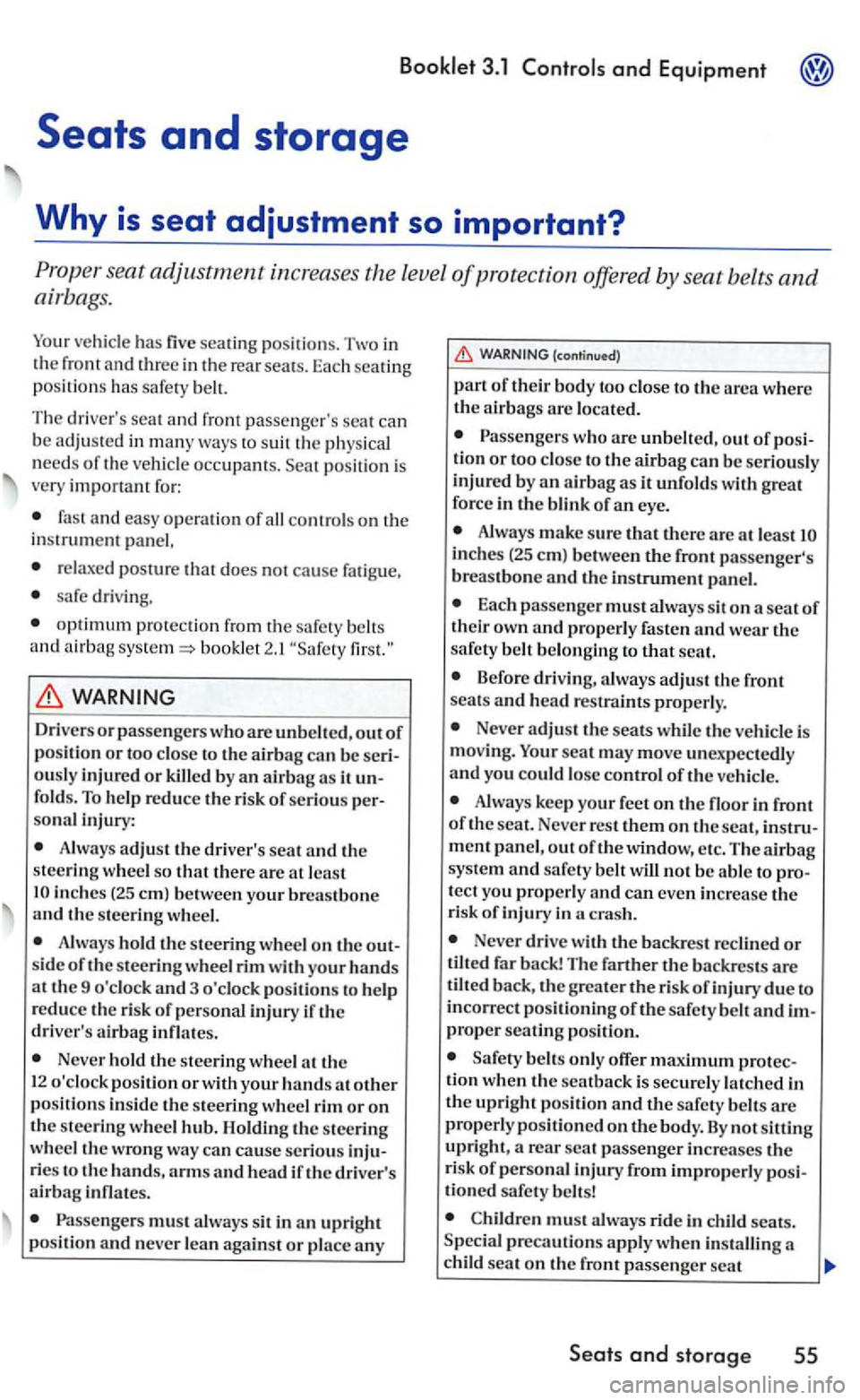
Booklet 3.1
passe nger's seat can
b e adju ste d in many ways to suit the physical
need s of the vehicl e occ upants. position is
very important for:
fast and easy operat ion of all control s on the instrument panel,
safe driving ,
optimum prote ction from the s afet y belts
and airb ag booklet 2.1
Driv ers or passengers who are unbelted, out of position or too close to the airb ag can be seri
ously injured or killed by an airbag as it unfolds. To help reduce the risk of serious personal injury:
Always adjust th e driver's seat and the steeri ng whe el so that there are a t lea st in ches (25 em) betwe en you r brea stbone and the ste erin g w heel.
Always hold the steering wheel on the out
s ide of th e s teering wheel rim with your hands at the 9 o'clock and 3 o'clock position s to he lp
reduce the risk of personal inju ry if the driver 's airbag inflates.
Never hold the steering wheel
Passengers must always sit in an upright position and never lean agains t or pl ace an y
(co ntinued)
part of their body too close to the area where the airbags are loca ted.
Alway s make sure there are at least inch es (25 em) between instrument panel.
Eac h passenger must always sit on a sea t of their own and prope rly fasten and wear the safety belt belon ging to that scat.
Before driving, always adjust the front
seats and head r estraints properly.
Never adju st th e sea ts while the vehicle is
moving. sea t may move unexpec tedly and yo u could lose control of the vehicle.
Always keep your feet on the floor in front of the sc at. Never rest on tl1e in strument panel, out of the window, etc. The airbag
s ystem and safety belt will not be able to pro
te ct you properly and can even increase the
ri sk of injury in
Never drive with backres t reclined or tilted far backJ The the backres ts are t ilted back, greater risk of injury due to
incorrect positioning ofthe safety belt and im
proper seating position.
b elts only offer maximu m prot ec
tion when the se atback is securely lat ch ed in
Children must alway s ride in child seats.
Seats and storage 55
Page 228 of 444

adjustable front seats
fig. 52 are arranged in
Adjusting the seat forward and
backward
-up the lever and move the seat
ward or
- Release the lever and slig htl y move
the seat until it la tches into place .
seat bock forward and
backwards
-To fold forward th e seat back, pull tl1e
(only 2-door vehicles) up and fold
th e
seatback At th e same time you
can slid e th e seat to th e front to make entry
into t he bac k seat of the vehicl e easier.
- To fold backwards the seat back, first
s lide the seat completely back, then pull
th e up and fold th e seat back
W here appl icabl e
58 and storage
Adjusting the support12l
-Take your weight off the backrest and
turn the to adjust the
lumbar support.
Adju sting the backrest
- Take your weight off the backrest and
turn the
up or down to raise
or lower the seat.
T he curvature of the cu shioned area is mined by the senings made in th e lumbar gio n. This s up pons the natural curvature of the spine ve ry effect ively.
WARNING
Drivers or passen gers who are unbelted, out of positio n or too close to the airbag can be
in is seat adjustment so on page 55 .
WARNING
Never adjust the seats whil e th e ve hicle is
moving. seat may mov e unexpected ly
a nd you could lose control of the vehicle.
To reduce the risk of personal injury in an accide nt, front seat passengers must n eve r
ride in a moving ve hicl e with the seatback
jury from an out of position safety belt.
when adjusting the seat for height or in the far-and-aft di rec tio n. Adjusting th e
Page 256 of 444
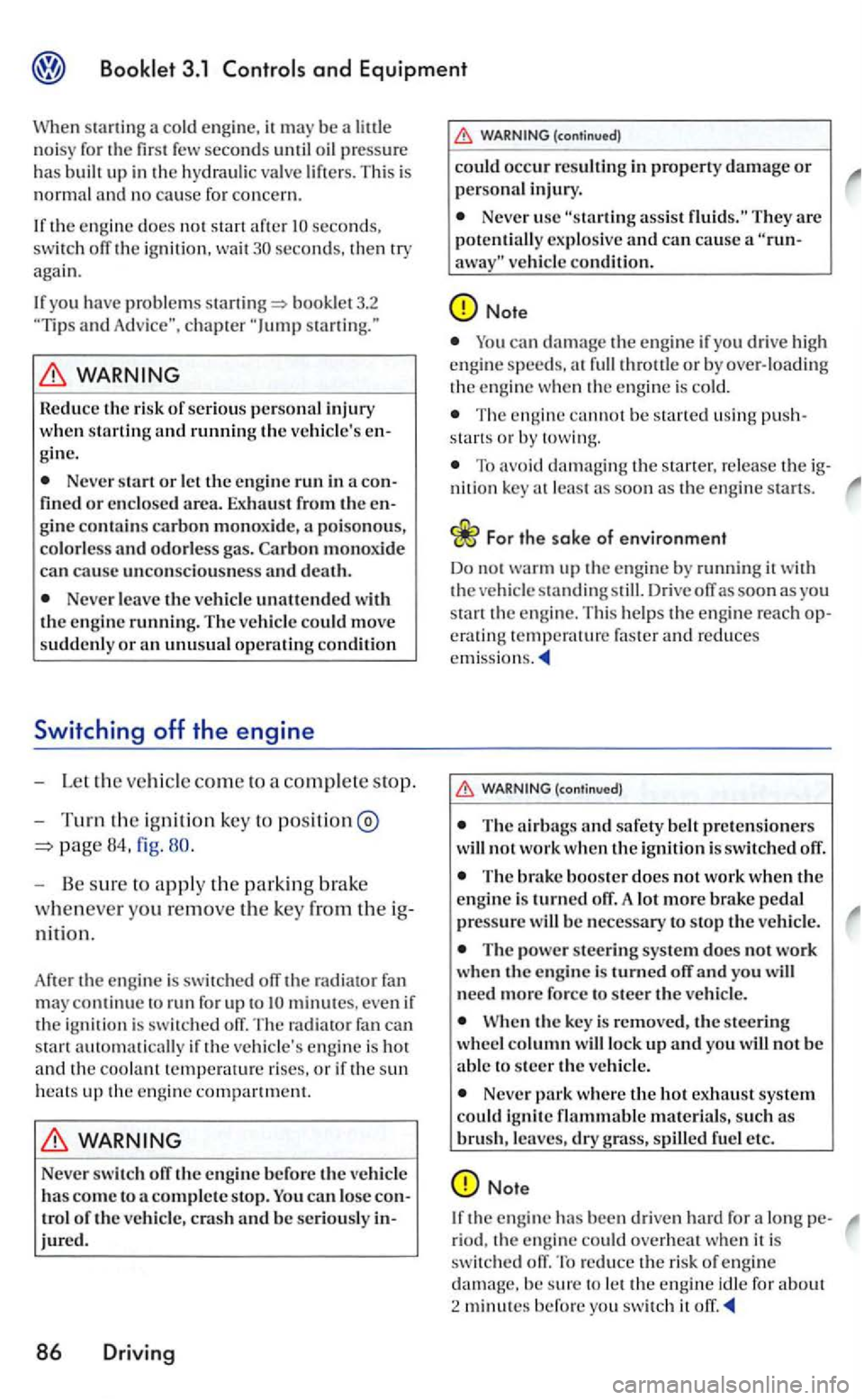
and Equipment
sta rtin g a co ld engin e, it may be a little
n o isy for the first few seconds until oil pressure has built up i n the hydraulic va lve lift ers . T his is normal and n o cause for concern.
I f
the engine does no t sta rt after seconds. switch off the ig niti on, wait seconds, then try
again.
I f yo u
have problem s booklet 3.2 and ch apter
g in e.
Never sta rt or le t the e ng in e run in fin ed or e n closed area. Exhaust from the poi so no us,
co lorless and odorless gas. Carbon can cause unco nsciou sness and death.
Never leave the ve hicl e unatt ended wit h the eng in e runnin g. The vehi cle could move
suddenly or an unus u a l o pe ra tin g condition
Switching off the engine
-Let the vehicle com e to a comple te sto p.
- T
urn th e ig nit ion key to pos iti on @
- Be sure to apply the par k in g brake
w he neve r yo u r
emove the key from the
nition.
Af te r the en gi ne is switched off the rad iator fan
m ay cont inu e to run for up co
Never sw itch off the engine before the vehicle
has com e to a complete stop. can lose tro l of the vehicle , crash and be seriou sly jured.
86 Driving
Neve r u sc "startin g assist fluid s." They are potentially explo sive and can cause a ve hicle cond it ion.
Note
can damage the engin e if you d rive hig h
e ngin e speeds, at full thro ttle or by over- loading
t h e e ngi ne whe n the engine is cold.
T he cann ot be sta rt ed usin g
To avoid the sta rt er, re lease the nition key as soon as the engin e starts.
For the sake of environment
Do not warmup the engine by running it w ith the ve hicle standing s till. Drive off as soon as yo u
s tart the engine. This help s the e ngine reac h
WARN ING (continued )
The airbag s and sa fety belt prc te n si one rs
will not work w hen th e ig n itio n is s wit ch ed off.
The brake booster does not wo rk w hen th e
engi ne is turned off. A lo t more brake pedal press ure will be necessa ry to sto p the vehicle.
T he power steering syste m does not work
whe n the eng in e is turned o ff and you w ill
need m ore force to s teer the vehicl e.
the ke y is remove d , the steerin g
wheel column will lock up and you will not be able to s teer th e ve hicle.
Neve r park whe re th e hot exhaust system could ignite flammable mate ria ls, su ch as brus h , leaves, dry grass, spilled fue l e tc.
Note
If the engine has been dri ven hard for a lo ng riod, th e engine co uld over hea t when it is
switched off. To reduce th e risk of eng ine damage. be sure co Ieee h e e ng in e idl e for about
2 min ute s befo re yo u sw itch it
Page 290 of 444
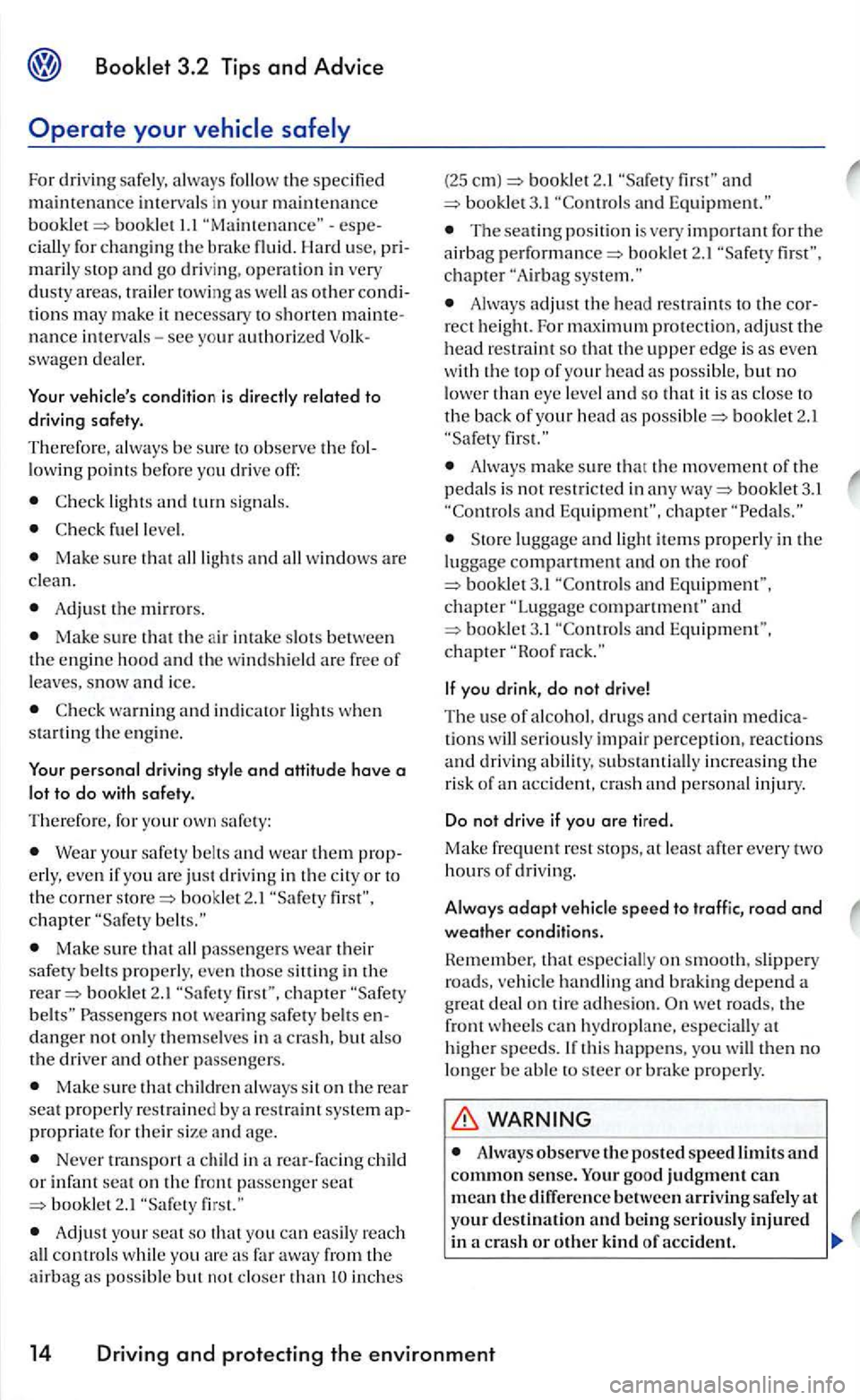
For dri ving safely. always follow the specified
maintenance int erva ls in your mainte na nce booklet 1.1 ciall y for changin g the brake fluid. Hard u se, maril y stop and go driv ing, o p eratio n in very dusty area s. trailer towing as well as other tions may make it necessary to short en nance in te rvals-see your a u th orize d swage n dealer.
Your
l ow ing po int s befo re yo u drive off:
lights and turn signal s.
Make sur e that all ligh ts and all windows are
clea n.
Adjust the mirro rs.
Make sure th at the a ir intake slots between the e ngin e hoo d and the w in d shi eld are free of leaves . s n ow and ice.
wa rnin g and indicato r light s whe n
s ta rti ng the e ng in e.
Your personal driving styl e and attitude have a
lot
to do with safety.
Th eref ore, for yo
ur ow n safety:
Wear your safety belts and wear the m
book let 2.1 chapter
Make sure that all passenge rs their safe ty be lls properly. eve n those sitting in the book le t2.1 chapter Passengers not wear ing safety bells
Make sure that chil dren always sit on the rea r seat properly restrain ed by
Neve r transport chil d in a r ear-faci ng c hild or infant seat on the fron t passe nger seat booklet2.1
Adjust you r seat that yo u can easily reach
all control s while yo u are as far away from the airbag as pos sibl e but not close r than
bookle t2.1 and bookle t3. 1
The seatin g position is ve ry important for th e
a ir bag book let2.1 chapter" Air bag
Always adjust the head rest ra int s to the rect heig ht. For maximum pro tection. adjust the
head restrai nt so the upper e d ge is as eve n
w ith the top of your head a s pos sibl e, but no lower than eye level and so that it is as close th e back of your head booklet 2.1
Always make s ure that th e movem ent of the
p ed als is not re stricted in any booklet 3.1 Equipment",
Sto re lu ggage and light it em s properly in the
lu ggage compartment and on th e roof bookle t3. 1 and Luggag e compartment " and book let3.1 and Equipment", chapte r " Roof
If you drink, do not drive!
The use of alco hol. drugs and certai n tions will seriou sly impa ir percepti on , reac tio ns and dri ving ability, substantially in creasin g the risk of an acc ident, cras h and persona l injury.
Do not driv e if you are tired.
Make frequ ent rest sto ps, least afte r every two hours of dri ving.
Always
adapt vehicle speed to traffic, rood and
weather conditions.
R e
member, that especially on sm oot h. slipp ery
roa ds, ve hicl e ha ndl ing and brak ing depend a
g reat deal o n tire adhes ion. wet roads, the
f ront w heels can h ydropla ne, especi ally at
hi ghe r speeds. th is happen s, yo u will then no
lon ger be abl e to steer or brake properly.
Alwa ys observe the p osted speed limits and common sense. good judg m ent can mean the diff ere nce b e tween arriving safely at your d estination and being seriou sly injured in a cras h or othe r kind of accident.
14 Driving and protecting the environment
Page 304 of 444
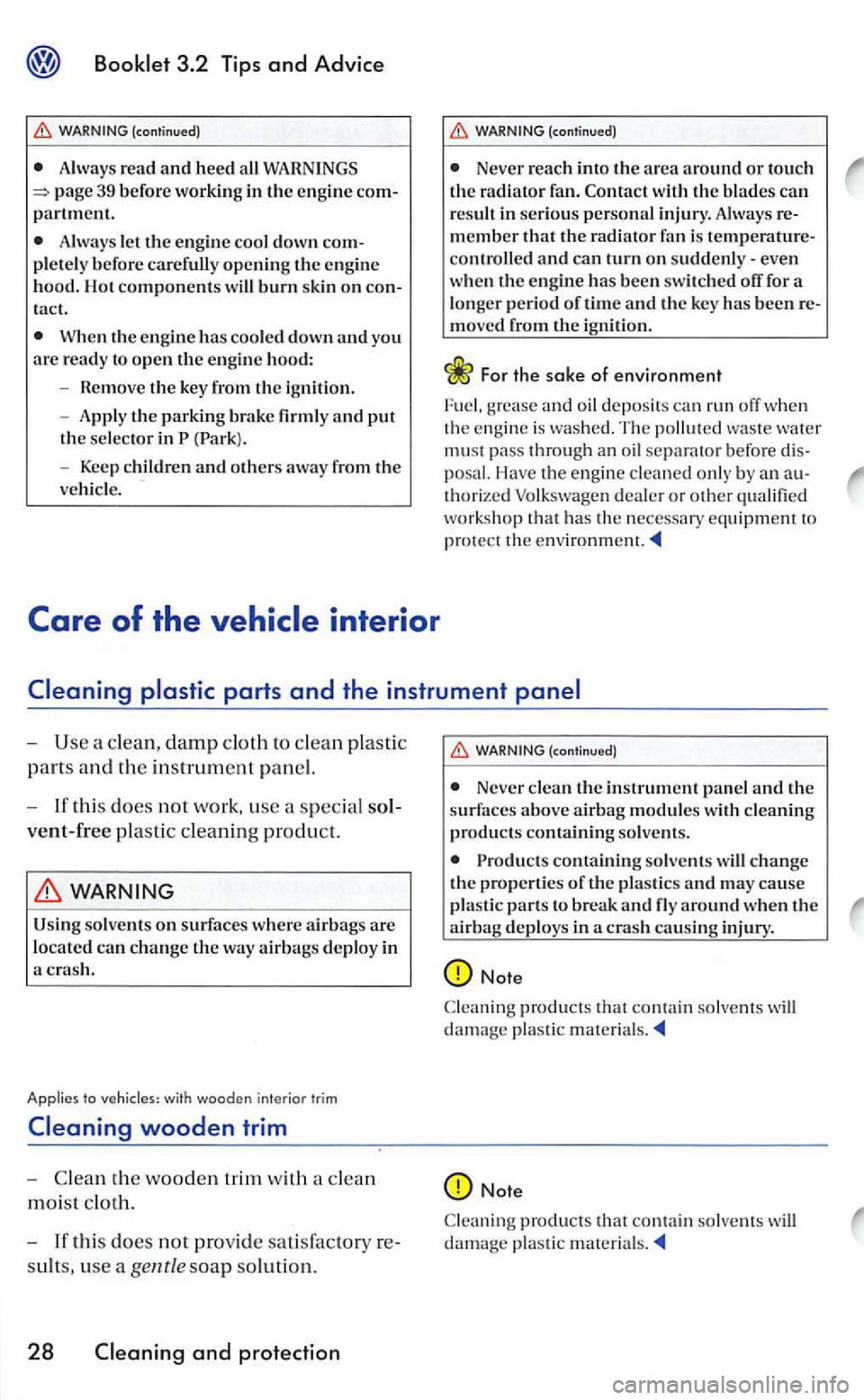
WARNING (continued)
partment.
Always le t the engin e cool down ple te ly befor e opening the engine
hood. Hot components will burn skin on
W hen the engine has coo led dow n and you are ready to open the eng in e hood:
- He move
the key from the ignition.
- Appl y th e
parking brak e firml y and put the selector in
-Keep c hildr en and others away from the vehicle.
WARNIN G (cont inued)
Neve r reach into the a rea around or touch
th e radi ator fan. w it h th e blad es can
r es ult in seriou s personal injury. Always
moved from the ign ition.
For the sake of environment
gre a se and oil dep osits can r un off when th e engi ne is was hed. The polluted waste water must pass th rough an oil se pa ra tor before posal. Have the engin e cl ea ned only by an
- Use a cl ean, damp cloth to clean plastic
parts and th e in strument panel.
- If thi s does not work, use a special
WARNING
so lvents on surfaces where airb ags are located can change the way airb ags deploy in
a crash.
with woode n interior ri m
thi s does not provide sa tisfac tory
sults, use a gentle soap solution.
28
(con tinued)
Neve r clean the instrument pan el a nd the
s u rfaces above airbag modul es with cleaning
products containing so lvents.
contain ing solvents will change
the p roperti es of the plas tics and may cause pla stic parts t o break and fly around w he n the
a irbag deploys in a cras h causing injury .
Note
products th at contain so lvents will damage plas tic mate ria ls .
product s that contain solvents will damag e plas tic materia ls .